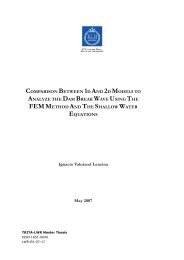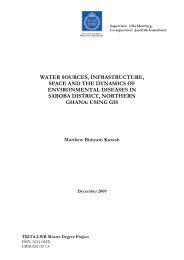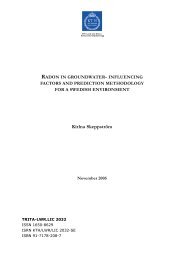POTENTIAL BIOGAS PRODUCTION FROM FISH WASTE AND ...
POTENTIAL BIOGAS PRODUCTION FROM FISH WASTE AND ...
POTENTIAL BIOGAS PRODUCTION FROM FISH WASTE AND ...
You also want an ePaper? Increase the reach of your titles
YUMPU automatically turns print PDFs into web optimized ePapers that Google loves.
Potential Biogas Production from Fish Waste and SludgeABSTRACTIn order to decrease the pollution of the marine environment from dumping fishwaste and by-catch, alternative use for co-digestion with sludge in anaerobic conditionwas studied. The purpose of this project is to optimize the methane potential fromadjustment of the proportion among mixed substrates. Ten groups of differentproportions among fish waste, by-catch and sludge were conducted with AMPTS IIinstrument under mesophilic condition (37 ± 0.5 ºC), by means of the principle ofBMP test. The ratio of inoculums and mixed substrate was set as 3:2. The optimal MPobtained after an experiment with 13 days digestion was 0.533 Nm 3 CH 4/kg VS fromthe composition of sludge, by-catch and fish waste as 33 %, 45 % and 22 %. It wasimproved by 6 % and 25.6 %, to compare with the previous studies by Almkvist(2012) and Tomczak-Wandzel (personal communication, February 2012) respectively.Key words: Anaerobic co-digestion; Methane potential; Biogas production;Fish waste; Sewage sludge; BMP.1. INTRODUCTIONThe problem and project are described in this chapter. In addition, thefinal destination of this project is also presented.1.1. Problem descriptionBaltic Sea, as the biggest brackish water area in the world, has a plentifulbiodiversity. It is situated in the east of Scandinavian Peninsula andJutland. It is also the internal sea of northern Europe, surrounded bymany countries. Its beneficial geographical position and abundant naturalresources contribute enormous efforts to the development ofsurrounding fishing and tourism industries, and the improvement ofpeople’s living standard. However, contaminants and wastes are thrownback into the Baltic Sea, causing enormous marine pollution, such aseutrophication due to the high content of nutrients in the water, oxygendepletion partly, and the decline of the species in the sea.With the rapid development of aquaculture and fishery, two of potentialcontaminants have been drawing more and more attention, which areby-catch (unwanted living creatures) and fish wastes including heads,viscera, skin, trimmings and fish rejects. Those are due to the increase ofhuman demands in fish meat and a lot of illegal fishing behaviors such asoverfishing and use of improper fishing gear (Mbatia, 2011). Discards ofdead by-catch and fish waste in the forbidden dumping location and overdumping quantity could bring enormous negative impacts on the marineenvironment, even they are natural pollutants. For instance, it can reducefish stocks and fish species, and bring negative effect on food web, aswell as cause alga bloom (Garcia et al, 2003). Consequently, fisheries areresponsible to protect the marine such as to keep fish stocks growsustainably and to maintain the biological diversity in Baltic Sea. Theiractivities should be conducted in an ecological way following manyprinciples and regulations.Normally, composting is the most used for disposal of fish waste and bycatch.One advantage of this process is that its residuals can be a soiladditive / fertilizer to improve the soil productivity (Laos et al, 1998).However, aerated composting is an energy consuming method, becauseair is pressed through the compost in order to avoid odor from the longtermstorage of fish waste and by-catch (Ferguson, 1990; Jeong & Kim,2001). Therefore, there is another alternative environmental friendly1
















